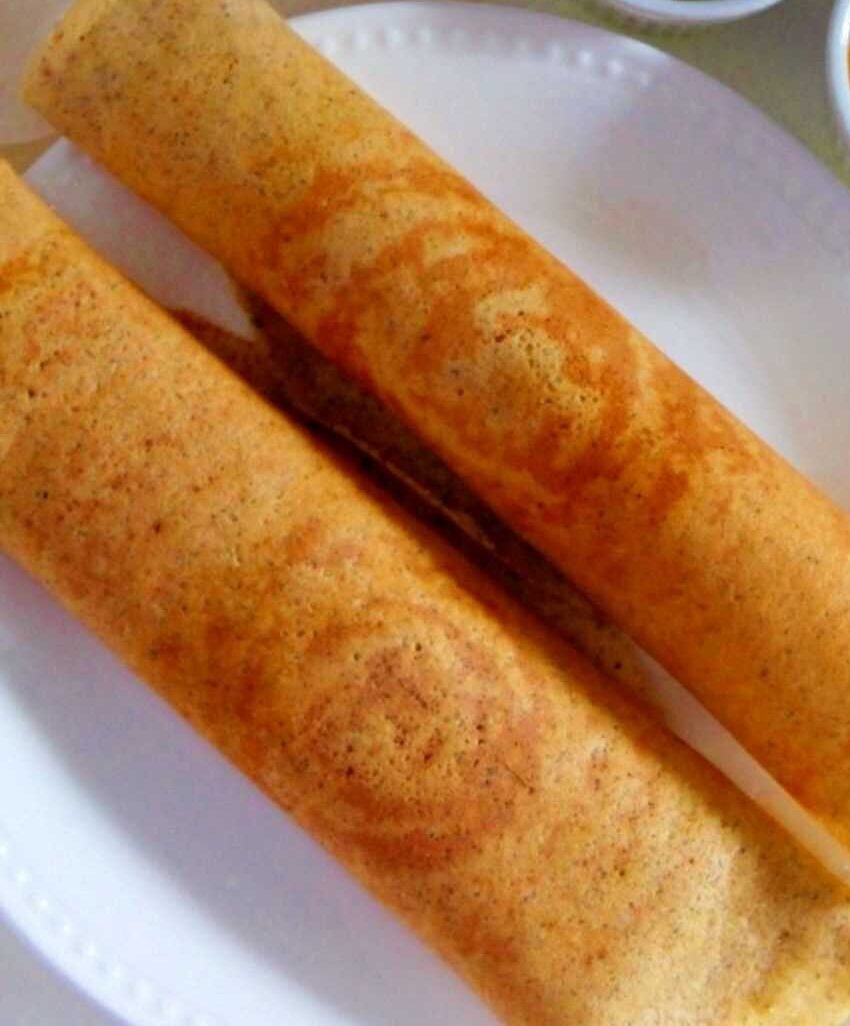Dosa: (Recipe)History, Ingredients, and Preparation
Introduction
Imagine waking up to the aroma of freshly cooked dosas, wafting through the air, making your taste buds tingle with anticipation. Dosa, a popular South Indian delicacy, is more than just a breakfast item; it’s a culinary masterpiece. In this article, we’ll take a delightful journey into the world of dosas, exploring their fascinating history, the key ingredients that make them special, and a step-by-step guide on how to prepare these delectable treats.

Chapter 1: The History of Dosa
Before we dive into the kitchen and learn how to make dosas, let’s take a step back in time to uncover the intriguing history of this beloved dish.
Dosa’s Ancient Origins
Dosa has a rich and ancient history that can be traced back over a thousand years in South India. It is believed to have its roots in the temple towns of present-day Tamil Nadu and Karnataka. Initially, dosas were known as “dosai” or “dose,” and they were quite different from the dosas we enjoy today.
These early dosas were made from a mixture of rice and urad dal (black gram), similar to the dosa batter we use today. However, the preparation method was different. The rice and dal mixture was left to ferment, creating a tangy flavor and a light, airy texture in the dosa. Fermentation not only added flavor but also made the dosa easier to digest.
Evolution of Dosas
As time passed, dosas evolved and took on many forms. One of the most famous variations is the “masala dosa.” This dosa is stuffed with a flavorful potato filling and is typically served with coconut chutney and sambar (a delicious lentil-based vegetable stew).
Dosas have transcended regional boundaries and are now enjoyed throughout India and even worldwide. They’ve become a versatile dish, with different regions putting their own unique spin on it. Some dosas are paper-thin and crispy, while others are soft and spongy. Each version has its own charm and appeal.
Chapter 2: Key Ingredients
Now that we have a glimpse of dosa’s history, let’s delve into the core ingredients that make this dish so special.
1. Rice
The primary ingredient in dosa batter is rice. Typically, short-grain or parboiled rice is used. These varieties yield a smoother and more delicate dosa. The rice provides the structure and crispness that dosa lovers crave.
2. Urad Dal (Black Gram)
Urad dal is another essential component of dosa batter. It adds a unique creaminess and helps with fermentation. Urad dal is rich in protein and nutrients, making dosas not just delicious but also nutritious.
3. Fenugreek Seeds
Fenugreek seeds, also known as methi, are often added to dosa batter. These tiny seeds contribute a slight bitterness and a distinct aroma to the batter. They also aid in the fermentation process.
4. Salt
Salt is the flavor enhancer in dosa batter. It brings out the natural taste of the rice and dal while helping to balance the fermentation process.
Chapter 3: Preparing the Perfect Dosa
Now that we have our ingredients ready, let’s roll up our sleeves and start cooking! Here’s a step-by-step guide to preparing a mouthwatering dosa.
Step 1: Soak the Rice and Urad Dal
- Measure 1 cup of rice and 1/4 cup of urad dal.
- Rinse them thoroughly in cold water.
- Place the rice and urad dal in separate bowls and cover them with water.
- Add a pinch of fenugreek seeds to the urad dal.
- Allow them to soak for at least 4-6 hours, or overnight.
Step 2: Blend the Batter
- Drain the soaked rice and urad dal.
- Using a blender or wet grinder, grind the urad dal first, adding water gradually until it becomes a smooth, fluffy paste. It should have a light and airy texture.
- Transfer the urad dal paste to a large mixing bowl.
- Grind the rice next, adding water as needed. The rice paste should be smooth but slightly grainy in texture.
- Combine the rice and urad dal pastes in the mixing bowl.
- Add salt to taste and mix the batter thoroughly. The consistency should be like that of pancake batter.
Step 3: Ferment the Batter
- Cover the mixing bowl with a clean cloth or plastic wrap.
- Allow the batter to ferment in a warm place for 8-12 hours or until it doubles in volume. The fermentation time may vary depending on the temperature and humidity in your kitchen.
Step 4: Prepare the Dosa
- Heat a non-stick or cast-iron skillet (preferably a flat griddle called a tava) over medium heat.
- Grease the skillet with a little oil or ghee (clarified butter).
- Pour a ladleful of dosa batter onto the center of the skillet.
- Using the back of the ladle, spread the batter in a circular motion to form a thin, even layer. The thinner the dosa, the crispier it will be.
- Drizzle a few drops of oil or ghee around the edges of the dosa.
- Cook the dosa until it turns golden brown and crispy on the bottom.
- Flip the dosa using a spatula and cook the other side for a minute or two. It should have a light golden color.
- Remove the dosa from the skillet and serve it hot with coconut chutney and sambar.
Chapter 4: Serving Suggestions and Variations
Dosas are incredibly versatile and can be served in various ways to suit your taste. Here are some serving suggestions and popular dosa variations:
1. Chutneys:
Dosas pair wonderfully with a variety of chutneys, such as coconut chutney, tomato chutney, and mint chutney. These condiments add a burst of flavor to every bite.
2. Sambar:
Sambar is a traditional South Indian lentil and vegetable stew that makes a perfect accompaniment to dosas. The tangy and spicy flavors of sambar complement the mild taste of dosas beautifully.
3. Masala Dosa:
As mentioned earlier, masala dosa is a popular variation that includes a spiced potato filling. To make it, simply stuff your dosa with a generous helping of potato masala before folding it over.
4. Paneer Dosa:
For a twist, try a paneer dosa. Grated paneer (Indian cottage cheese) mixed with spices can be used as a filling or spread over the dosa.
5. Onion Dosa:
Add finely chopped onions and green chilies to the dosa batter for a flavorful onion dosa. The onions become caramelized and crispy during cooking.
Conclusion
Dosa, with its long and storied history, is not just a dish; it’s a culinary tradition that has captured the hearts and taste buds of people across the globe. Its simplicity in terms of ingredients and preparation is a testament to the genius of South Indian cuisine.
So, the next time you savor a crispy, golden dosa with a side of coconut chutney and sambar, remember the centuries of culinary craftsmanship that went into creating this delicious masterpiece. Whether you enjoy it for breakfast, lunch, or dinner, dosa is a dish that continues to bring joy and satisfaction to food lovers everywhere. So, why not give it a try in your own kitchen and experience the magic of dosa for yourself?

